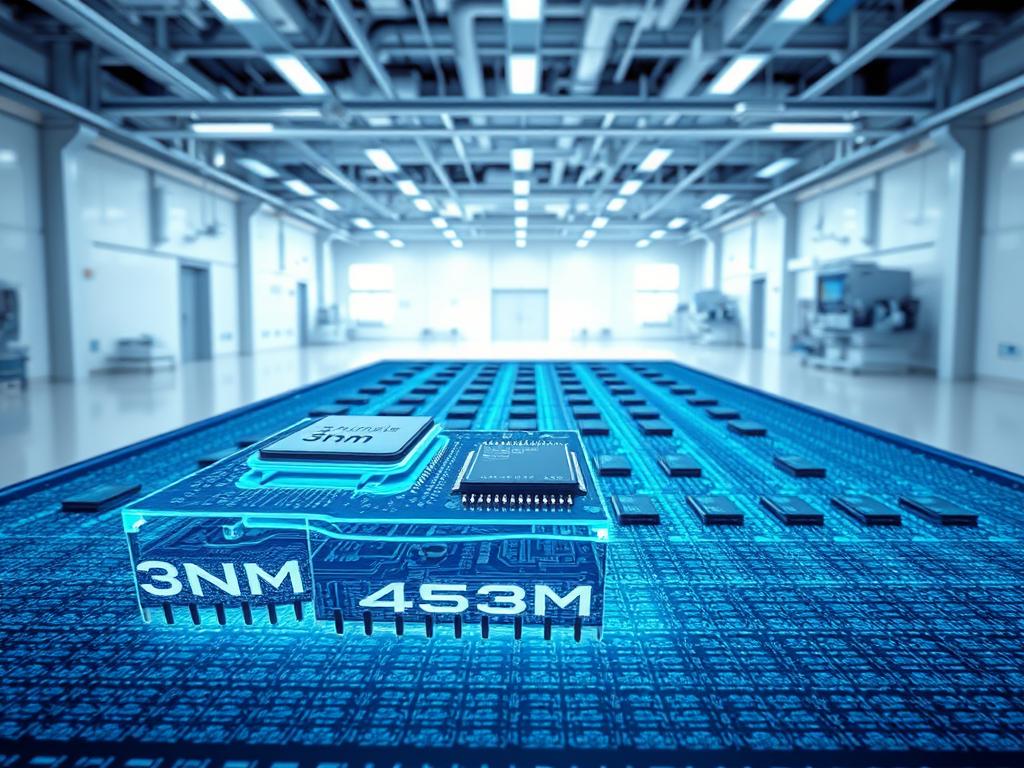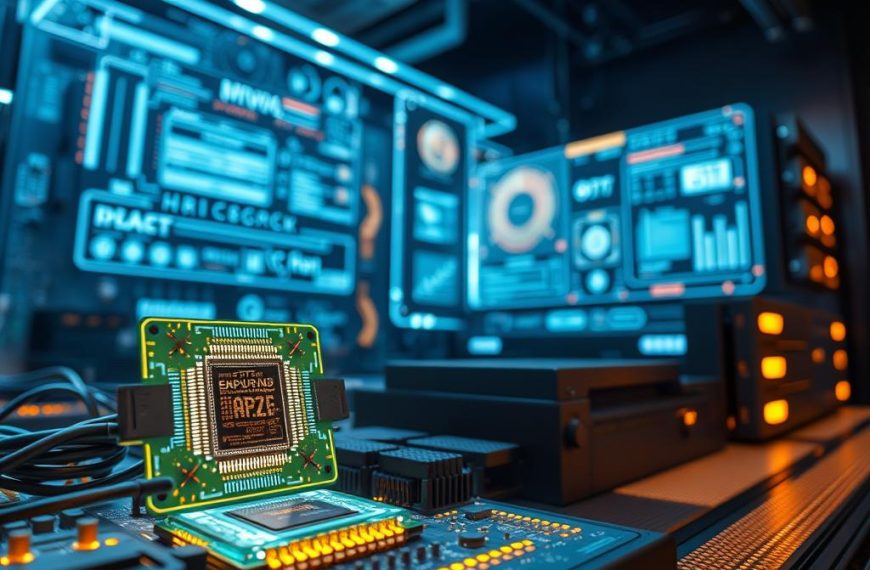3nm technology is transforming semiconductor manufacturing. It’s a massive leap in electronic design, pushing the limits of nanometre scale engineering. This approach will change how we create electronic devices.
3nm technology is a milestone in semiconductor production. It allows engineers to pack transistors more densely, cutting power use and boosting performance. Compared to 5nm, it uses 45% less power and improves performance by 23%.
Samsung and TSMC are leading this tech revolution. They use Gate-All-Around (GAA) technology and advanced manufacturing processes. These innovations unlock new potential for electronic devices.
The second-gen 3nm process promises even more. It could cut power use by 50% and boost performance by 30%. This will impact everything from smartphones to AI systems.
3nm tech will enable more powerful, efficient, and compact electronic solutions. It’s an exciting time for the semiconductor industry. The future looks brighter than ever before.
What is 3nm Technology
3nm technology is revolutionising semiconductor manufacturing. It’s a quantum leap in chip performance and innovation. This cutting-edge process is creating more powerful and efficient processors than ever before.
Semiconductor makers are pushing the limits of what’s possible. They’re developing chips that promise to transform computing as we know it.
Defining the Technology
3nm technology refers to an advanced semiconductor manufacturing process. It allows for unprecedented transistor density on chips. The “3nm” name represents the scale, though actual measurements are more complex.
This process packs more transistors into smaller spaces. As a result, it dramatically improves chip performance and power efficiency.
Evolution of Semiconductor Nodes
- Progression from larger manufacturing nodes (10nm, 7nm, 5nm)
- Continuous miniaturisation of semiconductor components
- Improved control over electrical current flow
Key Technological Features
The 3nm process introduces several groundbreaking innovations:
| Feature | Performance Improvement |
|---|---|
| Transistor Density | Up to 60% increase compared to 5nm process |
| Power Efficiency | 32% reduction in power consumption |
| Speed Performance | 18% improvement at same power levels |
TSMC’s advanced manufacturing techniques are particularly noteworthy. They use Gate-All-Around (GAA) transistors for superior electrical control. This allows companies like Apple and MediaTek to develop remarkably sophisticated processors.
The semiconductor industry keeps pushing technological boundaries. Research is already focusing on 2nm processes and beyond. Demand for high-performance, energy-efficient computing continues to grow.
3nm technology leads this exciting technological evolution. It’s shaping the future of computing and electronics.
The Revolutionary Impact on Semiconductor Manufacturing
3nm technology is transforming the semiconductor industry. It’s reshaping chip production with groundbreaking lithography techniques. This innovative leap represents a quantum jump in manufacturing capabilities.
Key developments in 3nm manufacturing include enhanced transistor density. This allows billions of transistors in smaller spaces. It also offers significant performance improvements over previous generations.
Revolutionary Extreme Ultraviolet (EUV) lithography techniques are another crucial development.
- Enhanced transistor density allowing billions of transistors in smaller spaces
- Significant performance improvements over previous generations
- Revolutionary Extreme Ultraviolet (EUV) lithography techniques
TSMC and Samsung are pioneering advanced production methods. These dramatically improve chip performance. The 3nm process enables a 10-15 fold increase in performance compared to 5nm chips.
It maintains similar power levels. Critical advancements include higher resolution lithography techniques and reduced mask layers in production.
Improved manufacturing yield rates are also a key factor.
- Higher resolution lithography techniques
- Reduced mask layers in chip production
- Improved manufacturing yield rates
The 3nm technology represents more than incremental progress—it’s a fundamental reimagining of semiconductor manufacturing.
These breakthroughs will revolutionise multiple industries. Mobile computing and artificial intelligence will benefit greatly. They’ll gain unprecedented processing capabilities with remarkable energy efficiency.
Leading Companies and Their Innovations in 3nm Production
Chip makers are racing to perfect 3nm production. This competition is reshaping advanced chip manufacturing. It’s driving unprecedented innovations across the industry.
The 3nm technology is a critical milestone for semiconductor manufacturers. Each company is developing unique approaches to overcome complex challenges.
TSMC’s Groundbreaking N3 Technology
TSMC has emerged as a dominant force in 3nm production. They’ve shown remarkable technological prowess with their N3 technology.
- 100% capacity utilization for 3nm processes
- Contributed 15% of total revenue in Q2
- Wafer pricing around US$20,000
- Expanding monthly capacity from 100,000 to 125,000 wafers
Samsung’s Innovative Approach
Samsung has introduced its distinctive Gate-All-Around (GAA) implementation. However, they face challenges in market penetration. Their first-generation 3nm node (SF3E) has found limited use in niche markets.
| Manufacturer | 3nm Performance | Market Share Trend |
|---|---|---|
| TSMC | Industry Leading | Increasing |
| Samsung | 10-20% Lower Performance | Declining |
Intel’s Strategic Direction
Intel continues to develop its strategic roadmap. They’re positioning themselves among the key players in semiconductor technology.
Major clients like Apple, Qualcomm, and MediaTek are preparing significant product launches. These will use advanced 3nm processes.
The ongoing innovations in 3nm production promise transformative capabilities. They’ll impact computing, mobile devices, and emerging technologies. This signals an exciting era of semiconductor advancement.
Performance Benefits and Technical Advantages
3nm technology marks a giant leap in semiconductor design. It offers unmatched performance improvements in energy efficiency, processing power, and transistor density. These advancements are truly revolutionary in the field.
Key performance benefits of 3nm technology include:
- Up to 35% power efficiency improvement over previous generations
- 15-20% performance gains at consistent power levels
- Significantly increased transistor density
3nm chips can pack about 1.6 times more transistors than 5nm technologies. This increase allows for more complex computational capabilities. It also enables the creation of more compact and powerful chips.
| Performance Metric | 3nm Improvement |
|---|---|
| Power Efficiency | Up to 35% reduction |
| Processing Performance | 15-20% performance gain |
| Transistor Density | 1.6x increase |
Real-world applications show these advantages clearly. Apple’s A17 Pro chip, made using 3nm technology, boasts 20% better GPU performance. This improvement highlights the transformative potential of this breakthrough semiconductor technology.
The semiconductor industry has invested over $15 billion in research and development. This huge sum shows how important 3nm advancements are. These innovations will reshape computing across mobile, data centre, and AI platforms.
Applications and Industry Transformations
3nm technology is set to revolutionise multiple industries. It will drive advancements in next-generation devices and smart technology. This semiconductor breakthrough promises to transform our interaction with technology across various sectors.
The evolution of semiconductor technology is creating remarkable opportunities. It’s fostering innovation across multiple domains. This progress is opening new avenues for technological advancement.
Mobile and Computing Devices
Next-generation devices will experience remarkable performance enhancements. TSMC’s 3nm process technology offers significant improvements. These include speed, power efficiency, and transistor density.
- Up to 15% speed improvement
- 30% power efficiency reduction
- 1.7x increased transistor density
Artificial Intelligence and Data Centres
AI advancements are poised for exponential growth with 3nm technology. Semiconductor sales for AI are projected to reach USD 100 billion by 2025. This growth is driven by unprecedented computational capabilities.
Automotive and IoT Applications
The automotive sector is becoming a significant semiconductor consumer. Electric vehicle sales surpassed 14 million units in 2023. Advanced Driver-Assistance Systems (ADAS) are expected to grow at 19.8% annually.
Semiconductor technologies continue to evolve rapidly. We’re witnessing a transformative era in technological innovation. The boundaries of what’s possible are constantly expanding.
Conclusion
3nm technology marks a turning point in innovation. A single chip’s design costs now reach $650 million. This investment shows the industry’s dedication to advancing technology.
The semiconductor landscape is changing fast. By 2037, node sizes may shrink to 0.5nm. Engineers keep breaking barriers, creating more efficient and powerful technologies.
Future semiconductors aren’t just about smaller chips. They’re gateways to solving global challenges. Each size reduction opens doors to smarter, greener tech solutions.
Semiconductor progress is driving global tech advancement. 3nm technology will reshape our capabilities in various fields. It will expand the limits of what we thought possible.















